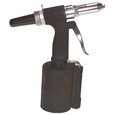Pneumatic Rivet Gun
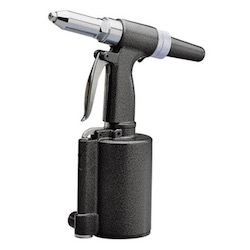
Figure 1: Pneumatic rivet gun
A pneumatic rivet gun uses compressed air to install blind rivets through two or more components, binding them together. Pneumatic rivet tools are frequently found in transportation, aerospace, metal manufacturing, construction, and other large-scale industries.
There are several advantages to pneumatic riveting over manual riveting, especially for large projects. A pneumatic riveting gun offers better performance with less margin for error and operates faster than a manual riveter. In addition, they can place multiple rivets in a short period of time, without placing the physical strain on the operator's hands that a manual riveter would. Besides the ergonomic advantages, pneumatic rivet guns deliver precise riveting each and every time, with less margin for error.
Table of contents
- Rivet gun operation
- Pneumatic rivet gun parts
- Pneumatic rivet guns pros and cons
- System Components
- Selection criteria
- Applications
- FAQs
View our online selection of pneumatic rivet guns!
Rivet gun operation
A pneumatic rivet gun uses 90 to 100 pounds (41 to 45 kgs) of air pressure per square inch to set a rivet. In Figure 2, there is a rivet in its original state (Figure 2 labeled A). The rivet gun pulls the mandrel (yellow) through the body of the rivet, deforming the back of the body and compressing the rivet head against the riveted surfaces (Figure 2 labeled B). Once the mandrel is tight enough against the material, it snaps off, providing a clean and properly sealed application (Figure 2 labeled C).
In order for the blind rivet to embed into the hole, air pressure must be high enough to contract the rivet body, which seals the joint. In the last part of the process, the excess air will escape from the chamber while a spring pushes the piston back to its initial position, leaving it ready for a new riveting cycle.
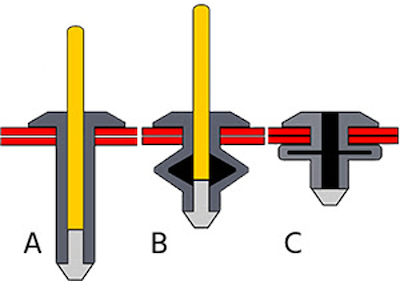
Figure 2: Pop rivet stages of compression: Rivet in its original state (A), rivet head compression (B), and proper sealing (C)
Pneumatic rivet gun parts
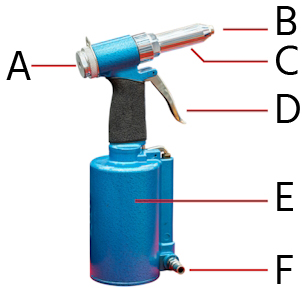
Figure 3: Parts of a pneumatic rivet gun: Capture cup (A), nose piece (B), jaw case assembly cover (C), trigger (D), cylinder (E), and air inlet (F).
A pneumatic rivet gun’s nose piece (Figure 3 labeled B) holds the rivet during installation. Additional nose pieces come with the rivet gun to accommodate different sized rivets. A user can replace a nose piece using a special wrench that also comes with the air rivet gun. Typically, rivets are 2-20mm in diameter and 5-50 mm in length.
The jaw case assembly cover (Figure 3 labeled C) contains the jaws that hold onto the rivet’s mandrel and pull it back during rivet installation. The nail ejector (Figure 3 labeled A) ejects rivet mandrels that shoot back when they break off of the rivet head. Depending on the orientation of the rivet gun, mandrels may instead fall out of the nose piece.
A user squeezes the trigger (Figure 3 labeled D) to cause air to flow from the air compressor, into the air inlet (Figure 3 labeled F) and into the cylinder (Figure 3 labeled E). Within the cylinder is a piston held in position by a spring. When air enters the cylinder, the piston pushes against the spring, which leads to the jaws pulling on the rivet’s mandrel until it snaps off, meaning the rivet is installed.
System components
- Compressed air source: To operate any type of compressed-air driven tool, it is necessary to have a proper supply of compressed air. A compressor is therefore an essential part of a pneumatic tool kit. Most air rivet tools will use 4 to 5 cubic feet/minute (8.5 cubic meters per hour) at 90 PSI (6.2 bar) under continuous use. A compressor will need to be able to supply at least that amount.
- Pneumatic hose: Pneumatic hoses are typically manufactured from plastics such as polyurethane (PU), polyethylene (PE) and polyamide (PA). PU is very flexible, kink resistant, and durable. PE is used for low pressure pneumatics. PA is strong and light, but less flexible than PE and PU. Learn more in our article about pneumatic hosing and tubing.
Pneumatic rivet gun types
There are two types of pneumatic rivet guns: a pneumatic pop rivet gun and a pneumatic rivet nut gun.
- Pneumatic pop rivet gun: An air operated pop rivet gun is the main focus of this article and has a nose piece that pop rivets (Figure 4 right) fit into. A pop rivet is also referred to as a blind rivet.
- Pneumatic rivet nut gun: This type of pneumatic rivet gun has a threaded bar nose piece that rivnuts (Figure 4 left) thread onto.
Learn more by reading our rivet gun types article.
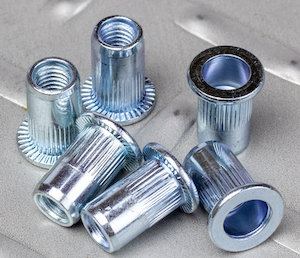
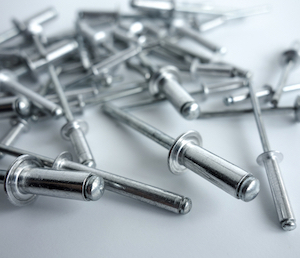
Figure 4: Rivet nuts (left) and pop rivets (right).
Pneumatic rivet guns pros and cons
Pros
- Provides more efficient, clean, consistent, and effortless riveting.
- Labor time is significantly lower compared to a manual rivet gun, driving down labor costs in small scale operations and large scale operations such as in the aerospace industry.
- High-quality sealing. A closed-end pop rivet is also known as a sealed blind rivet, or a sealing rivet, since they create a seal that is watertight when installed properly, making them a popular choice for boats and automobiles.
- Light in weight and easy to use.
- No need to recharge or change batteries.
Cons
- When an air rivet gun is not working, repair and maintenance can be difficult.
- The range is limited by the air hose’s length.
- An air compressor is needed.
Pneumatic rivet gun maintenance
Properly maintaining an air compressor rivet gun will ensure its long-lasting usability. The most common maintenance is properly lubricating the gun before use. Without proper lubrication, the rivet gun will quickly fail to operate correctly. There are three general use types:
- Periodic use: Lubricate the rivet gun before using it.
- Often but not continuous: Lubricate the rivet gun every day manually.
- Often and continuous: Lubrication happens automatically through the use of a oiler, fogger, or FRL unit.
Read our article on pneumatic tool oil to learn more about this essential part of working with an air-powered rivet gun and how to keep it properly lubricated.
Troubleshoot and repair
There are several symptoms that a rivet gun exhibits that indicate it is not working properly. For example, the pneumatic rivet gun can stop operating, the force of the riveter is inadequate, or the piston return is slow. These symptoms, among others, may require lubrication or part replacement to fix. Learn more about troubleshooting and repairing in our maintaining and repairing a pneumatic rivet gun article.
Selection criteria
The following criteria should be considered when selecting a pneumatic riveter for your application:
- Materials: The material from which an air powered rivet tool is made should be lightweight for ease of use over long periods. It should have an ergonomic rubber handle and a body made of high-pressure-resistant material, which will ensure long service life. Its terminations should withstand abrasion to avoid rust and damage from working conditions.
- Rivet body diameter: Every application is different, and the diameter of the blind rivets is an important factor that affects your choice when it comes to selecting a pneumatic rivet gun. It is desirable to have a tool that handles a large variety of rivet sizes, the most common sizes are 2 – 5 mm in diameter.
- Air inlet connection: An Rp ¼ connection nozzle between the hose and the pneumatic rivet gun is the most common.
- Riveting force: Heavy duty air rivet guns will deliver above 10 kN of pressure while more lightweight ones can only come close to 2 kN.
Applications
As a result of its many benefits, the industrial pneumatic rivet gun has become an essential tool for industrial applications. Some manufacturing sectors that employ these tools include:
- Aerospace industry
- Automotive industry
- Construction and modern architecture
- Metal fabrication industry
- Woodworking

Figure 5: The aerospace industry makes extensive use of pop rivets.
FAQs
What is a pneumatic rivet gun?
A pneumatic rivet gun is a mechanical tool that uses compressed air to install blind rivets through two or more components, binding them together.
How does a pneumatic rivet gun work?
A pneumatic rivet gun pulls the mandrel through the body of the rivet, deforming the back of the body and compressing the rivet head. Once the mandrel is tight enough against the material, it snaps off providing a clean and properly sealed application.
How do you use an air rivet gun?
Adjusting a pneumatic rivet gun is a simple process. Leave the compressor regulator set at 90 psi (6.2 bar), adjust the force of each blow with the dial at the base of the gun, hold the rivet gun against the solid surface and pull the trigger to test, finally adjust, and repeat if necessary. Once set up correctly, each rivet will be set the same.
What is a blind rivet?
A blind rivet is a two-piece metal fastening system, similar to a nail, that works as a junction between two different materials. It can be used to hold together surfaces such as wood, plastic, and most frequently metal.




